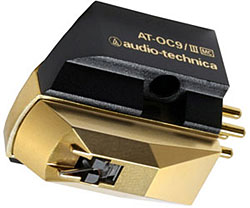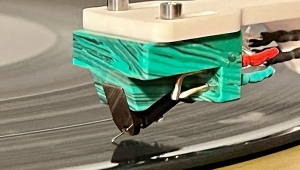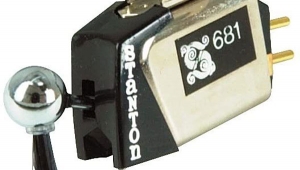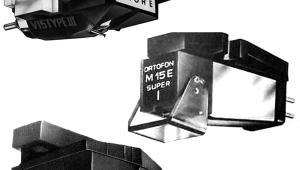| Columns Retired Columns & Blogs |
Audio-Technica AT-OC9 phono cartridge
 While the AT-OC9 bears the Audio-Technica logo, you won't find a sample of this moving-coil cartridge at your friendly Audio-Technica dealership. The US distributor of Audio-Technica products has apparently decided that their market does not include high-end cartridges. A quick perusal of the latest Audio directory issue (October 1988) lists the most expensive AT cartridge at $295, with no moving-coils in sight. When I first heard of the AT-OC9, the only reasonably accessible source, short of Japan, was Audio-Technica in the UK. A quick phone call and follow-up letter resulted in a review sample. Since that time, Music Hall in the US (footnote 1) importers of the Epos loudspeakers, among other items) has begun importing the AT-OC9 (along with the less-expensive AT-F5). Mail-order company Lyle Cartridges also stock it, I believe (footnote 2).
While the AT-OC9 bears the Audio-Technica logo, you won't find a sample of this moving-coil cartridge at your friendly Audio-Technica dealership. The US distributor of Audio-Technica products has apparently decided that their market does not include high-end cartridges. A quick perusal of the latest Audio directory issue (October 1988) lists the most expensive AT cartridge at $295, with no moving-coils in sight. When I first heard of the AT-OC9, the only reasonably accessible source, short of Japan, was Audio-Technica in the UK. A quick phone call and follow-up letter resulted in a review sample. Since that time, Music Hall in the US (footnote 1) importers of the Epos loudspeakers, among other items) has begun importing the AT-OC9 (along with the less-expensive AT-F5). Mail-order company Lyle Cartridges also stock it, I believe (footnote 2).
The Sound
The Audio Cheapskate also has a sample of this cartridge, and by now may have provided a report. As I write this, I know only that he is delighted with the OC9, and it is not difficult to see why. It is an excellent pickup, the best ever from Audio-Technica and one of the best from any source.
If forced to summarize the sound of the Audio-Technica in a few short words, I would (after protesting that such an over-simplification is difficult) classify the Audio-Technica as open and detailed, with good but not excellent transparency. The balance tends toward the analytic—a bit cool-sounding, but with enough warmth to prevent it from being too lean. Its highs are well-balanced, not at all reticent but not overbright or etched. Its dynamics are good, but not spectacular. Its deep bass is clean and solid. Depth and overall soundstaging are very good (though not quite top-caliber), the midrange three-dimensional. Its overall perspective is a bit laid-back. But the sound of the OC9 might best be characterized by comparison with the van den Hul and the Krell.
In the low end the Audio-Technica falls between the slight warmth of the van den Hul MC-One and the tightness of the Krell. The OC9 is neutral through the important midrange. It lacks any stunning attributes there, having neither the palpable clarity of the van den Hul nor the lively, dynamic contrast of the KC-100. Voices are a bit leaner and less fleshed-out than through the other two cartridges. In that respect it somewhat resembles the Monster Genesis 500, but the latter cartridge is definitely the leaner of the two, with a brighter balance.
The high-frequency response of the OC9 was, in many respects, the most well-proportioned of all the pickups in the present group. But I was bothered slightly by a trace of wispiness and dryness from recordings with strong high-frequency contents. On Ojebokoran (Opus 3 77-04), the voices were less liquid, without the fluid clarity of the same voices through the Krell or the van den Hul. Still, the HF response of the OC9 bettered that of the Krell and the MC-One in its open, airy quality and fine, delicate detailing. The Genesis 500 was equal or better than the Audio-Technica in HF transparency, without the latter's subtle dryness, but the Monster's highs were a shade too prominent.
The Audio-Technica fell short of the other three cartridges in the area of three-dimensionality, and was less effective in the re-creation of a well-layered sense of depth. But not by much. I never quite received the jaw-dropping sensation of front-to-back sculpturing occasionally provided by the others on the best material, but neither was I ever overtly conscious of a lack of three-dimensionality.
Conclusion
My personal ranking would place the OC9 just a shade behind the van den Hul MC-One and the Krell in overall sound. It is less alive and focused than the Krell, less sweet than the MC-One, and a bit less three-dimensional than either. But I'm unable to downgrade it by much; I simply spent too many long, thoroughly enjoyable listening sessions with it for that. It may be harder to find than the other pickups in this survey, but is worth a close audition.
Alvin Gold also wrote about the AT-OC9 in October 1988 (Vol.11 No.10):
Money is preferable to poverty, if only for financial reasons, and this forces me to keep my nose to the grindstone, sometimes for rather too many days in the month for comfort. I had planned to leave some time free from work, but the kids were screaming to be fed (after only a week!), my wife was petitioning for subsistence. . . . It seems events always have a way of asserting themselves, and I barely stirred from my desk the whole month.
What kept me so busy? Well, at the start of the month I was busy with an issue of Hi-fi Choice called the "Collection," a kind of, well, er . . . a collection of, er, reviews in a magazine called, er, Hi-fi Choice of, well, expensive components of all types. My part in the magazine's downfall was to contribute reviews of some relatively expensive loudspeakers and turntable and arm components. Sorry—I'm falling into bad habits—I mean turntables and arms, of course. Later in the month I was engaged with ("to," says my wife) a bunch of CD players, so I think this month I'm going to talk about cartridges. I'm not about to introduce anything you've not heard (or heard about) before. Instead, I'll pontificate a little about some designs that are already quite familiar.
One of the cartridges I want to talk about, the Ortofon MC-3000 costs £800 in the UK ($1000 in the US), and the others cost less than half as much. But both make important contributions to what I was shocked to realize just recently is the world of the exclusive and the exotic, even though they're far too cheap to possess the title by right.
Only just realized? Well, yes. I've been caught out this way more than once. It's an occupational hazard. I spend so long so close to my job that it's not unusual to find myself overlooking the obvious, often over long periods. What's more obvious than to realize that the current range of Audio-Technica moving-coils has implications for other makers of cartridges far beyond the apparent pretensions of the products themselves? As I see it, the AT-OC7 and flagship AT-OC9 do nothing less than set the goalposts for cartridges which others must now measure up to. These cartridges are so competent and so well priced that they can't be ignored by their peers, and that includes some which cost several times as much.
In this country at least, silly cartridge pricing was invented for the original Koetsu, which was released at a price level where no other cartridge with any record of success at all existed, unless you counted the odd Audio Note, etc. Now my words are not meant to disparage Koetsu, the legitimacy of whose prices is probably well justified, at least in most cases, by their superb performance standards. What I do believe, however, is that a number of other people saw the niche that Koetsu had created, dollar signs appeared in their eyes, and—at that point, cartridge pricing lost touch with reality. Prices certainly lost touch with the off-the-shelf styli, cantilevers, suspension components, and coils that they were made from.
Understand that I have no argument with the performance of most exotic designs. In the cases I'm thinking about, they're examples for which no apologies need be made. I argue only with the pricing. Audio-Technica has proved that they can make a cartridge that meets the very highest standards with a design that is essentially mass-produced, and which in this country costs £400. To pay more often amounts to nothing more than paying the price of exclusivity, as for a Rolex or a Patek Phillipe.
Well, exclusivity is fine for jewelry, but it's nonsense with equipment whose job description is primarily functional. Some of the prices being asked are beyond any possible justification. Audio-Technica has the proof of this assertion in the AT-OC7 and 9, but if you still want the best and can't quite stretch to these two models, don't ignore the AT-95E moving-magnet cartridge, which is more nearly OK than a number of low-end MCs. It's sharp and clear, mainly, and fundamentally well balanced. And you should be able to pick one up for a song—plus local sales tax.—Alvin Gold
Footnote 1: Audio-Technica apparently has no plans to distribute these cartridges in the US. Music Hall is therefore bringing some in from the UK—so-called "gray" importing.—Ed.
Footnote 2: As this copy went to press in December 1988, we were informed that Audio-Technica's Signet division will now be distributing the OC9 in the US. The cartridges will be subject a full quality control process and the price is expected to be in the $600–$700 region. The AT-OC9 is still in production in 2015 and costs $499. Web: www.audio-technica.com/cms/site/c35da94027e94819/index.html.—Ed.
- Log in or register to post comments



































